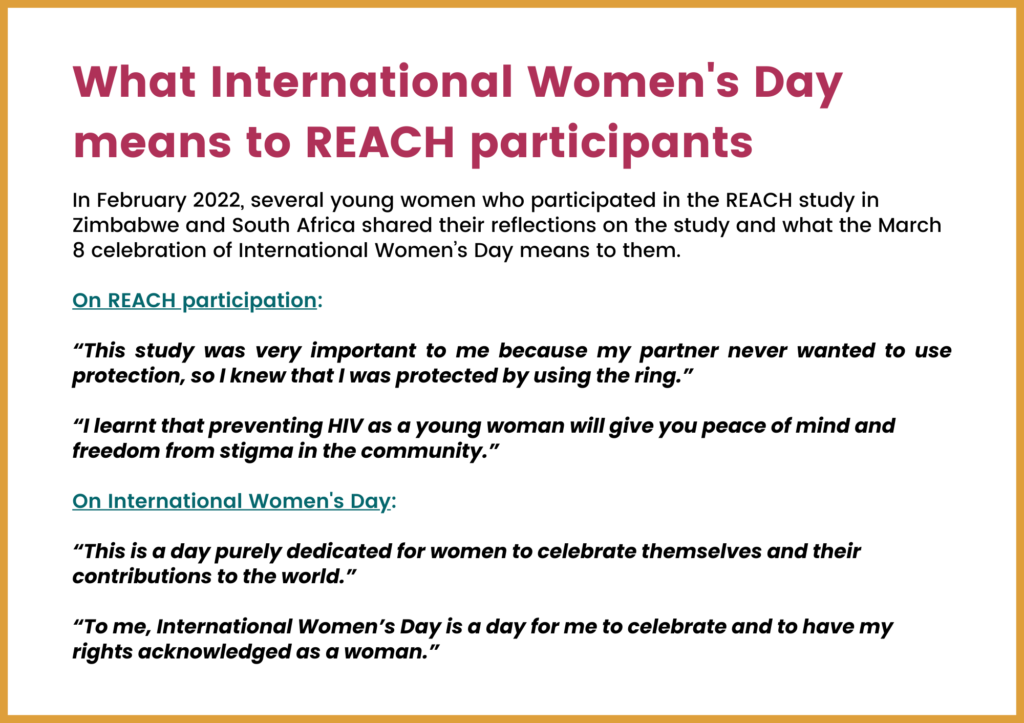Morgan Garcia, FHI 360
Today, we observe International Women’s Day, a day to celebrate the many achievements of women around the globe. This day also provides us with a moment to reflect on gaps that remain in our efforts to achieve gender equity and the realization of full sexual and reproductive health and rights for all.
One’s right to choose when, how, and with whom we are intimate, and the right to decide the outcomes of these choices lies at the heart of our right to own our sexual and reproductive health. The contraceptive field has come incredibly far in providing choice for those who have the ability to become pregnant. While few would argue that any contraceptive method is perfect or that all barriers to contraceptive use have been removed, many of us now have the opportunity to weigh our options among pills, injections, vaginal rings, implants, and more.

This International Women’s Day, we are celebrating a major milestone toward achieving choice, but in HIV prevention. Results from the MTN-034/REACH study were released in February 2022 and represent exciting news for a new choice in HIV pre-exposure prophylaxis (PrEP). REACH explored the safety, acceptability of and adherence to the dapivirine vaginal ring (the ring) and daily oral PrEP among approximately 250 participants ages 16–21 who were assigned female at birth.
In summary, REACH found that…
- Both the ring and oral PrEP were very acceptable to participants: 89% thought the ring was acceptable, and 64% said the same about oral PrEP.
- There were no safety concerns related to use of the ring or oral PrEP among participants.
- Participants were able to use both the ring and oral PrEP well in the context of the individualized support provided by the study; biological adherence measures (levels of drug in the blood or in returned rings) suggest that participants were at least somewhat adherent at more than 95% of study visits.
- When given a choice between using the ring, oral PrEP, or no product, participants overwhelmingly chose to use a product – 98% of them! Of those participants, 67% chose the ring, and 31% chose oral PrEP.
Interestingly, participants who used oral PrEP very well when assigned to use it were more likely to select oral PrEP when given the choice, while participants who chose the ring did so regardless of how well they had used it when assigned. Although further exploration is pending as analysis is ongoing, these findings suggest that adolescent girls and young women (AGYW) will choose to use oral PrEP if they believe they can use it well. The findings also suggest that AGYW may find the ring acceptable to take up and use if they choose not to use oral PrEP.
REACH participant Chantel Manganye, age 20, says using a product she did not have to disclose to anyone made her feel empowered.
“New products like the ring will give AGYW like me more choices to prevent HIV,” adds Manganye, who joined the Wits Reproductive Health and HIV Institute (RHI) as a Community Liaison Officer after participating in the study. “In a world that is full of patriarchy, I can walk into a health care facility, access services, and choose a method that best suits me. These new products give me power and control over my life and health.”
REACH has provided important safety information about the ring that will help national stakeholders consider whether and how to make this product available to AGYW in their countries. The study results also emphasize how crucial choice can be when it comes to HIV prevention — if AGYW who cannot or do not want to use oral PrEP are given access to the ring, it could be a complete game changer for PrEP uptake.
On this year’s International Women’s Day, the MOSAIC team is excited and energized to support countries as they embark on expanding HIV prevention options for AGYW, including the ring and other new products under regulatory review, such as long-acting injectable cabotegravir (CAB PrEP), and to celebrate this milestone accomplishment toward sexual and reproductive health rights for all.

Featured Image: Members of the REACH study team gather in Kampala, Uganda (Lisa Rossi/Microbicide Trials Network).
Featured Illustration: Marco Tibasima/REACH


